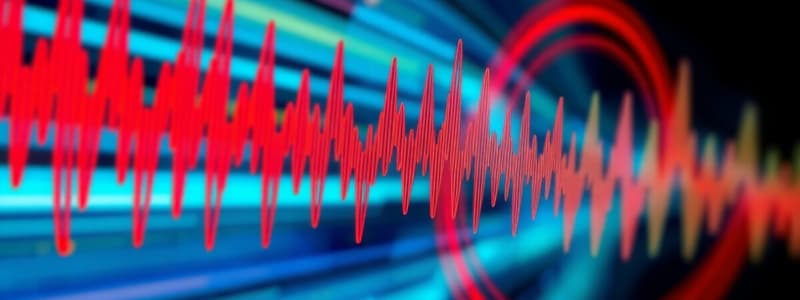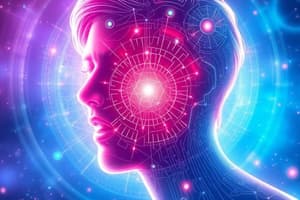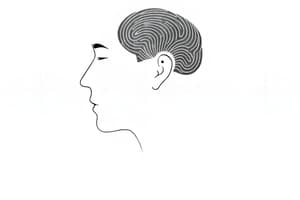Podcast
Questions and Answers
What does the word boundary hypothesis relate to in speech recognition?
What does the word boundary hypothesis relate to in speech recognition?
- Identifying speaker identity
- Variability and disfluencies in speakers (correct)
- The ability to pick up speech at high speeds
- Setting the correct frequency for speech signals
Which of the following is NOT a challenge of speech recognition?
Which of the following is NOT a challenge of speech recognition?
- Speaker identity verification (correct)
- Variability in ambient acoustics
- Large vocabularies in all languages
- Speaking rate variability
What does the semantic layer in speech production consist of?
What does the semantic layer in speech production consist of?
- Meaningful elements such as words and phrases (correct)
- Contextual aspects of conversation
- Sound patterns of speech
- Physical configuration of the vocal apparatus
What is the goal of extracting information from speech?
What is the goal of extracting information from speech?
How does closed set identification function in speaker recognition?
How does closed set identification function in speaker recognition?
In speaker verification, what does it mean if the system accepts an identity claim?
In speaker verification, what does it mean if the system accepts an identity claim?
What type of identification allows for the possibility that the speaker may not be known to the system?
What type of identification allows for the possibility that the speaker may not be known to the system?
Which layer of speech recognition involves the physical sounds produced during speaking?
Which layer of speech recognition involves the physical sounds produced during speaking?
Flashcards
Speech Recognition (SR/ASR)
Speech Recognition (SR/ASR)
The process of converting spoken language into text.
Speech Variability
Speech Variability
Variations in the way a word is spoken due to factors like speaking rate, pronunciation, and regional accents.
Speaker Identification
Speaker Identification
The process of determining the speaker's identity by analyzing their voice.
Speaker Verification
Speaker Verification
Signup and view all the flashcards
Word Boundary Hypothesis
Word Boundary Hypothesis
Signup and view all the flashcards
Multilayer Structure of Speech
Multilayer Structure of Speech
Signup and view all the flashcards
Extracting Information from Speech
Extracting Information from Speech
Signup and view all the flashcards
Acoustic Layer of Speech
Acoustic Layer of Speech
Signup and view all the flashcards
Study Notes
Speech Signal: Time Domain
- Speech is a sequence of different sound types
- Vowels are periodic
- Fricatives are aperiodic
- Examples include "has" and "watch"
Utterance Types
- Glides have smooth transitions, like "watch"
- Stops have transient bursts, like "dime"
Speech Signal: Frequency Domain
- Displays the speech signal as a function of frequency
- Illustrated in a graph with frequency on the x-axis and log power on the y-axis
- Shows the power spectrum of different components in the frequency domain
Automatic Speech Recognition (ASR)
- Converts speech signals into words
- Output can be used as input for natural language processing
- Recognizes speech from a speaker, converting it to words a computer can understand
Speech Recognition Process
- Input: Speech signal from a human
- Output: Text representation of the speech
- Steps include recognition, synthesis, generation and understanding of text
Speech Recognition: Main Diagram
- Signal (speech waveform) is converted to digital form
- Speech pattern is compared to models to determine units needed in the output
- The most optimal response is found using established constraints
Speech Recognition Difficulties
- Word boundary hypothesis: continuity, variability, and disfluencies in speakers
- Speaking rate variability in a number of situations
- Large vocabularies in all language and varieties
- Variability in ambient acoustics and microphone characteristics affects the ability to recognize speech in different environments
- Background noise
Speech Production/Perception
- The process of converting thoughts/ideas to a speech signal
- Diagram shows different phases involved.
- Speech production: from thoughts to acoustic signal
- Speech recognition: converting acoustic signals to understandable text and meaning
- Machine counterparts represent the systems involved, for example, printed text to the neuro-muscular movement.
Multilayer Structure of Speech Production/Recognition
- Pragmatic layer: Contextual information affecting the message
- Semantic layer: The literal meaning of the message
- Syntactic layer: The word order/syntax of the message
- Prosodic/phonetic layer: The melody and accents in the message
- Acoustic layer: The physical sound/waveform characteristics of the speech
ASR System Capabilities
- Speaking modes: range from isolated words to continuous speech
- Speaking styles: vary from read speech to spontaneous speech
- Enrollment: can be speaker-dependent or speaker-independent
- Vocabulary: varies from small to large
- SNR (signal-to-noise ratio): can range from high to low
- Transducer: from noise-cancelling microphones to cell phones
Information Extraction from Speech
- Speech signal is used to determine speaker identity
- Goal is to automatically extract information contained in a speech signal
- Speech recognition converts the speech signal to words
- Speaker recognition identifies the speaker based on their speech characteristics.
Speaker Identification
- Determines speaker identity from a known set of voices
- Closed set: all voices are known; open set: not all voices are known
- This is different from speaker verification, which determines if a claimed identity is valid.
Speaker Verification
- Synonyms: authentication, detection
- User claims an identity
- System task: to accept or reject the claimed identity
- Closed set scenario: all possible speakers are known to the system
- Impostor: All voices except the true speaker identity being matched to the claimed identity
Speaker Verification System Phases
- Enrollment phase: speech data from each speaker is collected and processed to create models
- Verification phase: a new speech sample is compared to the collected models to determine speaker identity
Verification Performance
- Many factors need to be considered, such as
- Speech quality: Channel/microphone characteristics, noise levels, and the differences in speech between enrolment and verification sessions
- Speech modality: text-based or free form speech
- Speech duration: Number of sessions of verification compared to enrollment sessions
- Speaker population size
Studying That Suits You
Use AI to generate personalized quizzes and flashcards to suit your learning preferences.




